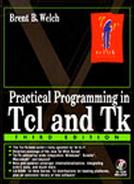Tcl Commands
Tcl stands for Tool Command Language. A command does something for you, like output a string, compute a math expression, or display a widget on the screen. Tcl casts everything into the mold of a command, even programming constructs like variable assignment and procedure definition. Tcl adds a tiny amount of syntax needed to properly invoke commands, and then it leaves all the hard work up to the command implementation.
The basic syntax for a Tcl command is:
command arg1 arg2 arg3 ...
The command is either the name of a built-in command or a Tcl procedure. White space (i.e., spaces or tabs) is used to separate the command name and its arguments, and a newline (i.e., the end of line character) or semicolon is used to terminate a command. Tcl does not interpret the arguments to the commands except to perform grouping, which allows multiple words in one argument, and substitution, which is used with programming variables and nested command calls. The behavior of the Tcl command processor can be summarized in three basic steps:
- Argument grouping.
- Value substitution of nested commands, variables, and backslash escapes.
- Command invocation. It is up to the command to interpret its arguments.
This model is described in detail in this Chapter.
